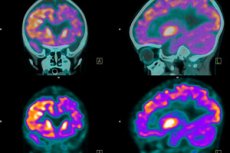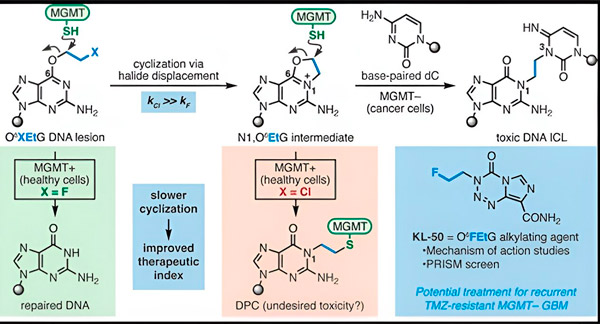Scientists create 'chameleon' compound to treat drug-resistant brain cancer
Sist anmeldt: 14.06.2024

Alt iLive-innhold blir gjennomgått med medisin eller faktisk kontrollert for å sikre så mye faktuell nøyaktighet som mulig.
Vi har strenge retningslinjer for innkjøp og kun kobling til anerkjente medieområder, akademiske forskningsinstitusjoner og, når det er mulig, medisinsk peer-evaluerte studier. Merk at tallene i parenteser ([1], [2], etc.) er klikkbare koblinger til disse studiene.
Hvis du føler at noe av innholdet vårt er unøyaktig, utdatert eller ellers tvilsomt, velg det og trykk Ctrl + Enter.

A new study led by Yale University researchers describes how a new chemical compound attacks drug-resistant brain tumors without damaging healthy surrounding tissue.
This research, published in the Journal of the American Chemical Society, is an important step in the development of so-called "chameleon compounds" that could be used to combat a number of dangerous types of cancer.
Gliomas develop in approximately 6.6 per 100,000 people each year and in 2.94 per 100,000 people under the age of 14. With the exception of metastases from other cancers that reach the central nervous system, gliomas account for 26% of all brain tumors (primary brain tumors) and 81% of all malignant brain tumors.
For decades, patients with glioblastoma have been treated with a drug called temozolomide. However, most patients develop resistance to temozolomide within a year. The five-year survival rate for patients with glioblastoma is less than 5%.
In 2022, Yale University chemist Seth Herzon and radiation oncologist Dr. Ranjit Bindra developed a new strategy to more effectively treat glioblastomas. They created a class of anti-cancer molecules called chameleon compounds that exploit a defect in a DNA repair protein known as O6-methylguanine DNA methyltransferase (MGMT).
Many cancer cells, including glioblastomas, lack MGMT protein. New chameleon compounds are designed to damage DNA in tumor cells lacking MGMT.
Chameleon compounds initiate DNA damage by depositing primary lesions on DNA, which over time develop into highly toxic secondary lesions known as interstrand cross-links. MGMT protects the DNA of healthy tissues by repairing primary damage before it can develop into deadly interstrand cross-links.
For their new study, co-authors Herzon and Bindra focused on their flagship chameleon, KL-50.
“We used a combination of synthetic chemistry and molecular biology studies to elucidate the molecular basis of our previous observations, as well as the chemical kinetics that provide the unique selectivity of these compounds,” said Herzon, the Milton Harris Professor of Chemistry at Yale University. "We show that KL-50 is unique in that it forms interstrand DNA cross-links only in tumors with a DNA repair defect. It spares healthy tissue."

Source: Journal of the American Chemical Society (2024). DOI: 10.1021/jacs.3c06483
This is a significant difference, the researchers emphasized. A number of other anticancer compounds have been developed to trigger interstrand cross-links, but they are not selective for tumor cells, limiting their usefulness.
The secret to KL-50's success lies in its duration of action, the researchers noted. KL-50 forms interchain crosslinks more slowly than other crosslinkers. This delay gives healthy cells enough time to use MGMT to prevent cross-links from forming.
"This unique profile demonstrates its potential for treating drug-resistant glioblastoma, an area of large unmet clinical need," said Bindra, the Harvey and Kate Cushing Professor of Therapeutic Radiology at Yale Medical School. Bindra is also the scientific director of the Chenevert Family Brain Tumor Center at Smilo Hospital.
Herzon and Bindra said their study highlights the importance of considering rates of chemical modification of DNA and biochemical DNA repair. They believe they can use this strategy to develop treatments for other cancers that contain specific tumor-associated DNA repair defects.
